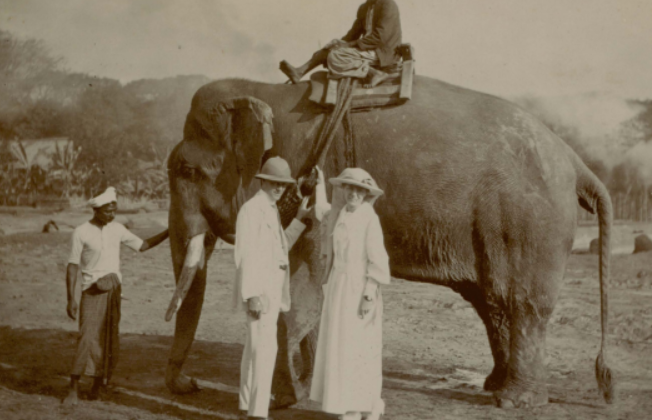Burma has had a long history of British colonial influence in their country. It was established as a colony under the British Empire in 1824 and it did not receive its independence until 1948. Throughout this over one hundred year period of colonial rule, Britis influence permeated throughout the colony. With the growing British influence, Burma started to become a somewhat popular tourist destination. Following the invention of Kodak film in 1888 (Reynolds 2022), personal photography became way more accessible and cheaper than it had ever been before. This caused and explosion in the practice of travel photography. Courtesy of the CU Digital Library’s “Early Photography of Asia” collection, there are hundreds of individual photographs and photo albums containing images of colonial Burma. From this collection, I have chosen to analyze an untitled photograph which depicts a British couple posed in front of an elephant from one of four photo albums taken by George West Phileo in Burma between 1917 and 1924. This photograph tells a lot about the history of Burma at the time it was taken by shedding light on power dynamics and the exoticization of this foreign country.
Before I can analyze the historical contexts of this photo and what they mean, I must first describe the photo itself. The photo depicts a British couple, dressed all in white, posing together in front of an elephant. They both are grabbing onto a strap that is connecting the wooden seat on top of the elephant to its body. Both the man and the woman are looking at the camera and smiling. There are two other people in the photo, both of which are Burmese men. One is seated in the seat attached to the back of the elephant and the other is standing in front of the elephant with the hand on the base of its trunk. Both of the men are wearing darker clothes and are barefoot and are not wearing hats, in contrast to the British couple whom are both wearing shoes and hats. Finally, the elephant itself is standing with its left side to the camera and its trunk resting on the ground. It also has tusks which means that it is male.
As a colonial power whose presence had been established for several decades, the British colonial government needed to establish control over the local population. One of the ways they did this was by attempting to censor the Burmese press. The reason colonial government did this was because they were, “concern[ed] with the British image [and used] censorship to ensure that the ruling power was never ridiculed” (Larkin, 2003, p. 64). The relationship between Britain and Burma, like many other colonial relationships, was one that came from an imbalance of power. Censoring the press was one way to keep authority over the Burmese people. The relationship between the people in this photo can easily be seen as one of colonizer and colonized. The British couple, with their expensive clothes and fancy camera, stand in stark contrast to the simply dressed Burmese men. It is clear from the positioning of the people in the photo that the men are not the subject. A subtle metaphor can be taken from this photo in how the colonial government would prefer Britain to be the primary focus in the building up of the colony rather than the people that were there before them.
Another major thing that stands out from this photograph is how it portrays Burmese culture. For many years, Europeans cultures have viewed Eastern or “Oriental” cultures as exotic and strange. Books like George Orwell’s Burmese Days is a good example of this. The novel, published in 1934, is based on Orwell’s own experiences in Burma during the 1920’s, the same time period that this photo was taken. Throughout this novel there is a strong theme of Orientalism which is a term used by historians which describes how colonial campaigns use “fabricated and falsified information about the Orient and its inhabitants in order to justify the civilizing mission of the West to redeem and save the Orient” (Shihada, 2014, p. 81). The presence of the elephant in this photograph is a very clear example of the exotication of Burmese culture. In a way, the elephant is the symbol of the “Orient”. It is strange and different and only exists outside of the Western world. The purpose of including the elephant in this photo is to show how exotic and wild the colony of Burma is, furthering the agenda of the colonial government who want to tighten control over the territory.
This photograph, which captures a British couple posed in front of an elephant, carries much darker themes of power dynamics within the colony, and the exotication of non-western cultures. Although it may not have been the intention of the photographer for this themes to be expressed, it is a silent reflection of the attitude at the time of the colonizer and the colonized.
